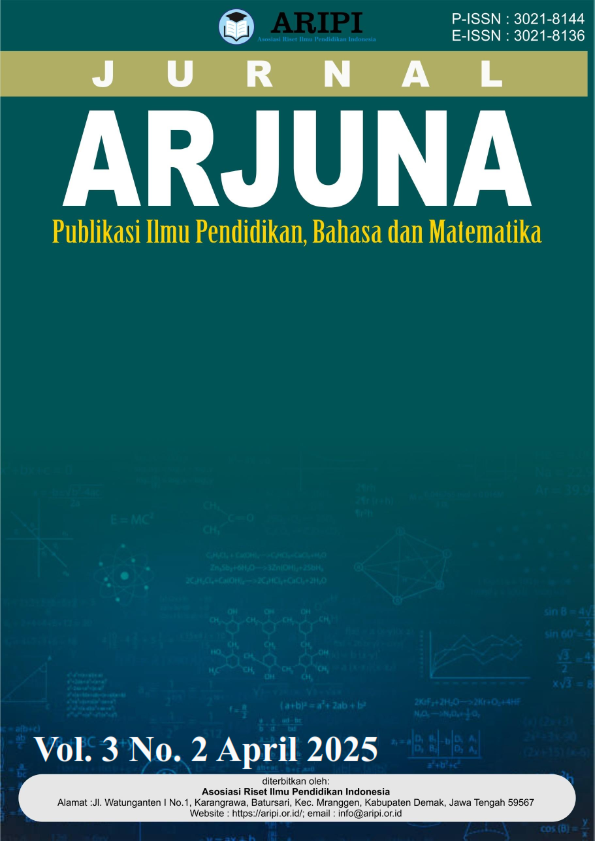Penerapan Kegiatan Melipat Kertas Origami untuk Mengembangkan Keterampilan Motorik Halus Anak Di Kelas B Ra Al-Hidayah
DOI:
https://doi.org/10.61132/arjuna.v3i2.1720Keywords:
Classroom Action Research, Early Childhood, Fine Motor, OrigamiAbstract
This study aims to develop children's fine motor skills through origami paper folding activities in class B RA Al-Hidayah. Fine motor skills are very important for early childhood because they affect their ability to do activities that require hand and finger coordination, such as writing, cutting, and drawing. Origami paper folding activities were chosen because they involve structured hand movements and train children's accuracy, patience, and creativity. This study uses the Classroom Action Research (CAR) method which is carried out in two cycles. Each cycle consists of planning, implementation, observation, and reflection stages. The subjects of the study were 20 children in class B RA Al-Hidayah. Data were collected through observation, field notes, and documentation of children's work, then analyzed descriptively qualitatively and quantitatively. The results showed that children's fine motor skills increased significantly after the implementation of origami folding activities. In cycle I, the percentage of children who achieved good category fine motor skills was 65%, and increased to 90% in cycle II. Children looked more skilled at controlling finger movements, folding neatly, and enthusiastically participating in activities. Thus, the implementation of origami paper folding activities is effective in developing children's fine motor skills in RA Al-Hidayah. This activity can be used as an alternative learning that is fun and beneficial for the development of early childhood.
Downloads
References
Allen, K. E., & Marotz, L. R. (2019). Developmental profiles: Pre-birth through adolescence (9th ed.). Cengage Learning.
Anderson, L. W., & Krathwohl, D. R. (2001). A taxonomy for learning, teaching, and assessing: A revision of Bloom's taxonomy of educational objectives. Longman.
Berk, L. E. (2022). Child development (11th ed.). Pearson Education.
Bodrova, E., & Leong, D. J. (2007). Tools of the mind: The Vygotskian approach to early childhood education. Pearson.
Creswell, J. W. (2012). Educational research: Planning, conducting, and evaluating quantitative and qualitative research. Pearson Education.
Dockett, S., & Fleer, M. (2018). Play and pedagogy in early childhood: Bending the rules. Routledge.
Erickson, H. L. (2007). Concept-based curriculum and instruction for the thinking classroom. Corwin Press.
Ginsburg, K. R. (2007). The importance of play in promoting healthy child development and maintaining strong parent-child bonds. Pediatrics, 119(1), 182–191. https://doi.org/10.1542/peds.2006-2697
Harun, R. (2018). Metode bermain dalam pembelajaran anak usia dini. Jurnal Pendidikan Anak Usia Dini, 3(2), 45–58.
Hedges, H. (2014). Young children’s ‘working theories’: Building and connecting understandings. Journal of Early Childhood Research, 12(1), 35–49. https://doi.org/10.1177/1476718X12466619
Isbell, R. T., & Exelby, B. (2019). Early learning environments that work. Gryphon House.
Jalaluddin, R. (2021). Pengaruh aktivitas melipat kertas terhadap perkembangan motorik halus anak. Jurnal Pendidikan Anak Usia Dini, 6(1), 12–24.
Jones, E., & Reynolds, G. (2011). The play’s the thing: Teachers’ roles in children's play (2nd ed.). Teachers College Press.
Kagan, S. L., & Kauerz, K. (2012). Early childhood systems: Transforming early learning. Teachers College Press.
Lincoln, Y. S., & Guba, E. G. (1985). Naturalistic inquiry. SAGE Publications.
McDevitt, T. M., & Ormrod, J. E. (2019). Child development and education (7th ed.). Pearson.
Miles, M. B., & Huberman, A. M. (2014). Qualitative data analysis: A methods sourcebook. SAGE Publications.
Moleong, L. J. (2017). Metodologi penelitian kualitatif. PT Remaja Rosdakarya.
Montessori, M. (1967). The absorbent mind. Holt, Rinehart and Winston.
Piaget, J. (1952). The origins of intelligence in children. International Universities Press.
Pianta, R. C. (2012). Handbook of early childhood education. Guilford Press.
Santrock, J. W. (2021). Child development (14th ed.). McGraw-Hill.
Saracho, O. N., & Spodek, B. (2003). Contemporary perspectives on play in early childhood education. International Journal of Early Years Education, 11(2), 123–130.
Sugiyono. (2020). Metode penelitian pendidikan: Pendekatan kuantitatif, kualitatif, dan R&D. Alfabeta.
Suyadi, & Ulfatin, N. (2020). Metode penelitian pendidikan anak usia dini. Prenada Media.
Vygotsky, L. S. (1978). Mind in society: The development of higher psychological processes. Harvard University Press.
Walsh, G., & Petty, K. (2020). Play and learning in early childhood education. Oxford University Press.
Wortham, S. C., & Hardin, B. J. (2016). Assessment in early childhood education (7th ed.). Pearson.
Wulandari, D. (2019). Stimulasi motorik halus anak usia dini melalui kegiatan seni lipat kertas. Jurnal Ilmu Pendidikan, 5(3), 211–225.
Yelland, N. (2010). Contemporary perspectives on early childhood education. Open University Press.
Downloads
Published
How to Cite
Issue
Section
License
Copyright (c) 2025 Jurnal Arjuna : Publikasi Ilmu Pendidikan, Bahasa dan Matematika

This work is licensed under a Creative Commons Attribution-ShareAlike 4.0 International License.






